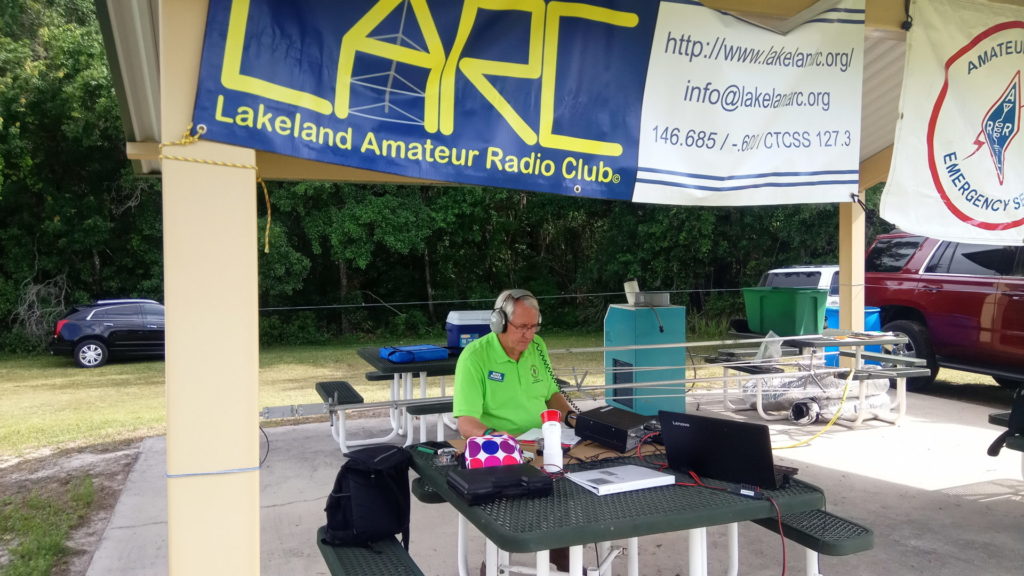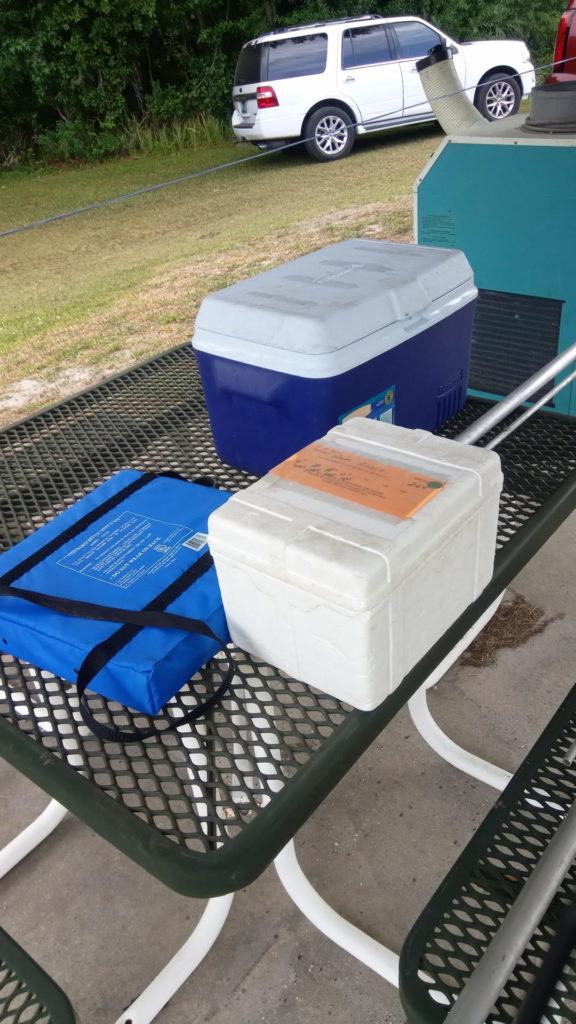As LARC meetings are the second Monday of the month, the June LARC meeting is Monday, June 14.
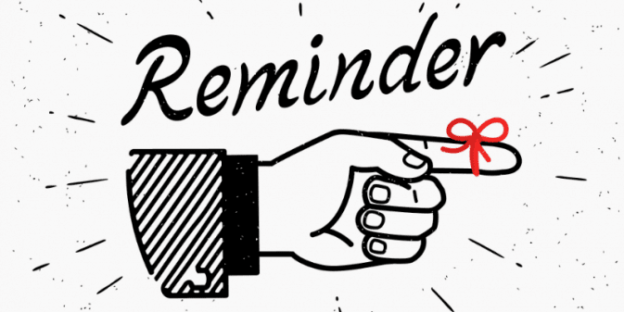


As LARC meetings are the second Monday of the month, the June LARC meeting is Monday, June 14.
Visualize this situation with me. You have been in ham radio for many years, and have worked RF, contesting, DXing, CW, satellites, digital modes, etc., with the best station that you could have put together. You have won awards left and right and have QSL cards from all over the world.
But, in the blink of an eye, through no fault of your own, things have now changed rapidly, and not for the better. Your health is declining, and you realize you are not as young as you used to be (no one is getting any younger). Where you live (an apartment, housing subdivision, etc.) is no longer going to allow antennas, RF gear, etc. Or you will have to move into an assisted living center or a medical facility…where RF gear is prohibited, because of possible RFI with medical equipment. The RFI could mean the difference between someone living and dying; and it would mean seemingly never-ending loneliness in your day (especially with visitation limits due to COVID-19).
Yet, this change does not mean that you must give up a lifelong hobby that you love. Rather, you change the way you operate…from RF to internet radio. Now, while the ham radio purists will abhor this, there are advantages:
1) You do not have to worry about RF exposure limits at your shack, since everything is done via your computer and high-speed internet.
2) You do not have to worry about the high cost of rigs, power supplies, TNC’s, SWR meters, coaxial cable, antennas, towers, masts, etc. Most of these modes are free, or at a very modest cost (some exceptions do exist).
3) You can operate portable with just a laptop computer, a headset mic (it cuts out ambient noise), and a portable Wi-Fi device, or high-speed internet. You can do a demo at a high school ham radio club or operate from the sleeping car compartment aboard a passenger train on a vacation trip.
4) Most importantly, you can still get on the air, and talk to people. Plus, for new hams, “mic fright” can be a very real issue to deal with.
You provide a copy of your license to the administrators, pay the applicable fees, install the software, and you are good to go. These include:
A) CQ100. Strictly VoIP (no RF), it offers simulated operations on several HF bands. You can do voice, or such digital modes as CW (via your keyboard or an external keyer), or PSK31 with Digipan or MixW. Cost is $39 a year in US or Canadian funds. Paid users get an add-on called QSO-TV, where you can send JPG files to all on the “frequency”. Usage is free on Sunday from 0000 to 2400 UTC. For new users, there is a free 30-day trial (QSO-TV is not available to trial users). There are also several nets that operate on CQ100, including the QCWA CQ100 Net that meets on Fridays at 11am Eastern Time, on 14.347 MHz on the 20-meter band of CQ100.
B) BlueDV. Done by PA7LIM, with a ThumbDV from NW Digital Radio (only $120), you can do D-Star, DMR, and Fusion, with your computer. With this, I do the QCWA Digital Net on the QuadNet Array (https://openquad.net) every Sunday at 5pm Eastern Time. Numerous other nets are available as well.
C) D-Rats. Originally done by KK7DS, now done by YO2LOJ and IZ2LXI, you can send messages (email and ICS), files, and chat in real time. There are also add-ons for weather data and maps; and some D-Rats Nets on the air.
D) Packet Via Telnet. The NS2B BBS in Penfield, NY, offers RF and Telnet access, and a digital net every Monday at 8pm US Eastern Time. I use the Outpost program, and its related iptelnet client.
E) Echolink. Available via computer or a smartphone app. You talk with hams having single user setups, or those on simplex links, repeaters, or conference servers. Numerous Echolink Nets are available to check into.
F) Winlink 2000, using the Winlink Express program. The registration cost is very reasonable, and you can send/receive messages via telnet or RF.
G) Remote Base Operations. There are some free services, but others can be rather expensive. Basically, another ham is allowing you to operate their station remotely.
For more info and related files, click on the hyperlink on my QRZ bio (my email is good there as well). I would be happy to assist anyone who’d like to operate this way. It makes my ham radio license not just “a sheet of
paper.” – Submitted by: Daryl Stout, WX4QZ, QCWA Life Member
Many thanks to QCWA and author Daryl Stout, WX4QZ, for allowing me to reprint this article from the June 2021 issue of the QCWA Journal. For further information or to inquire about membership (if you’ve been licensed for 25 years) please visit www.qcwa.org

Memorial Day Weekend…a weekend of beaches (as it traditionally marks the beginning of summer), barbecues (because it’s a holiday weekend and grilling is just understood), racing (the greatest single day of the year for the race fan as the Grand Prix of Monaco, the Indianapolis 500 and the World 600 are all on the same day) and let’s not forget ham radio…
Most important of all, let’s remember the meaning of Memorial Day…which is to honor all those who have made the ultimate sacrifice for their country. It’s not a day for parties and celebrations…rather it’s a day to honor and reflect, and to be thankful for those who gave their lives so that we can enjoy the freedom which we have. God bless you all.

It was decided at the April meeting of the LARC Board of Directors that in light of the ongoing Covid-19 uncertainty as well as the league’s rules favoring home stations that, as was done in 2020, the Lakeland Amateur Radio Club will forego it’s annual Field Day gathering. Anyone who wishes to do so is welcome to operate in the event is obviously welcome to do so, we just will not be sponsoring an official club station again this year.
For addition information and for the latest rules please visit http://www.arrl.org/field-day
Hams are notorious for being “frugal” (which is just a nice way of saying “cheap”). What could be better than a way to try out a new mode of communication and it doesn’t cost anything? If you’ve ever wanted to try DMR and have an android phone (you iPhoners will just have to go to Starbucks and talk about us), have I got good news for you. As the saying goes…”There’s an app for that”.
There’s a free app called “Droidstar“, and it will do lots of things…fun things like Fusion, DMR, P25, NXDN and others. But, since our ARRL WCF PIC (which is a whole lot easier than saying “Amateur Radio Relay League West Central Florida Section Public Information Coordinator”) and resident digital mode expert Mike Lunsford, KB4FHP gave such a great talk about DMR at the April LARC meeting, let’s go there.
Before you do anything else, go ahead and go to www.radioid.net and create an account there and request a DMR id. If you already have one, you’re ahead of the game.
Next, go to the Play store on your android phone (while the iPhoners are still on their first latte) and search for Droidstar. There is one option so select it and download it. You should get something like this (except the boxes will be empty):
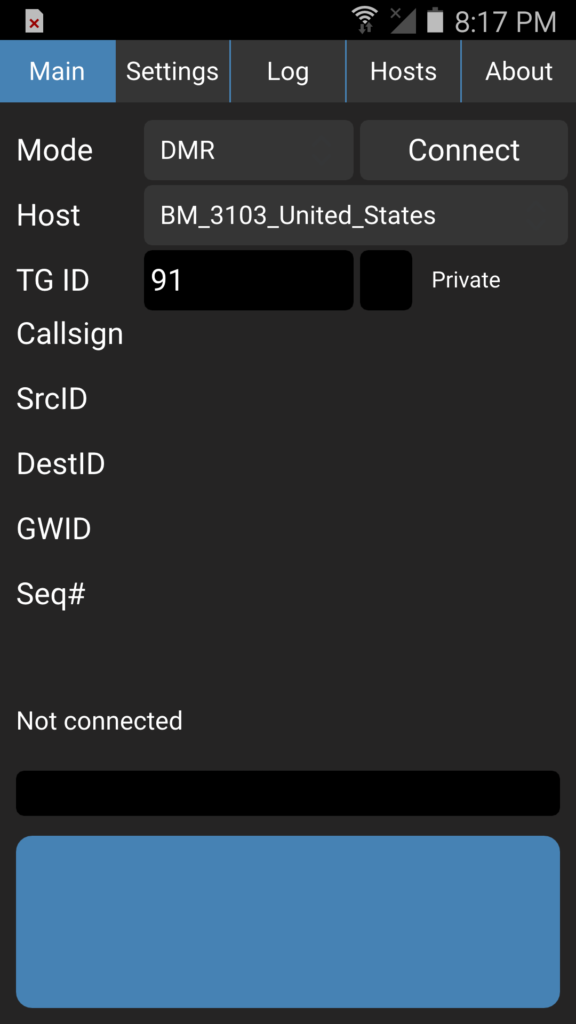
Click on “Settings” and you should see something like this:
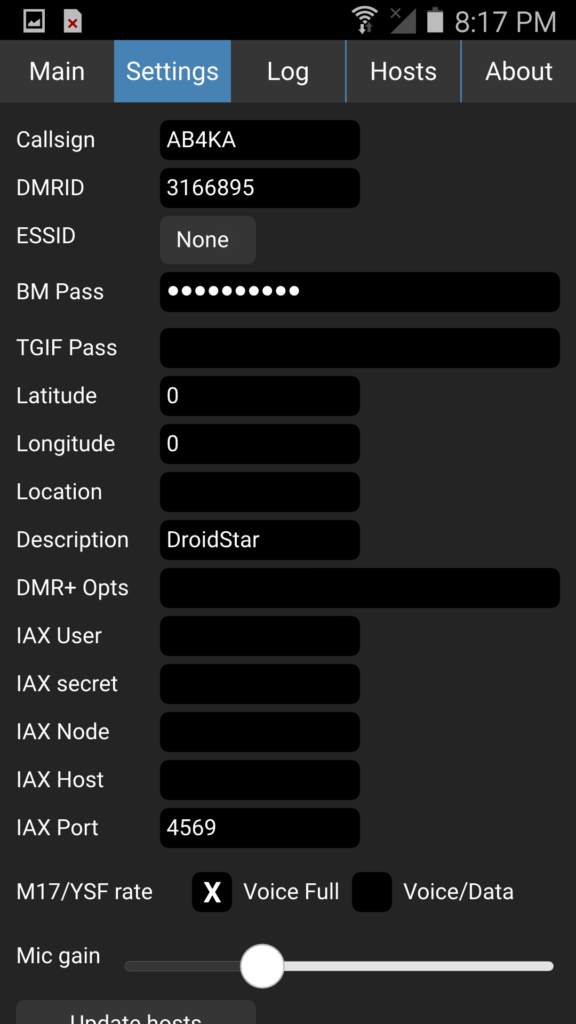
On this screen, enter your Callsign, DMR ID (which you probably have by now) and your Brandmeister Password (BM Pass) in this appropriate boxes. If you don’t have a Brandmeister account, go to www.brandmeister.com and set up an account with your new DMR ID and set a password. Don’t worry about entering anything in the other boxes, because there aren’t any instructions for this and your resident blogger doesn’t know what to put there 😉
After this is done and the screen looks something like the one pictured above, go back to the main screen. If you select the “Mode” box, a list of modes will open up. For this exercise, select “DMR”. Under host, again if you select the box, a list of hosts will pop up. Select 3102, 3103 or 3104 for the United States. Once this is done, change the TG ID (talk group) to 91 for Worldwide.
After all of this is done, hit “Connect” and hold on tight! If you’ve done it right (and the ghost of Hiram Percy Maxim is smiling upon you), shortly you will hear hams from all over the world talking to each other. What’s even better, by hitting the blue “TX” button on the bottom of the main screen, you can talk to those hams. Just be advised that the TX button toggles on and off and if you transmit and then walk away while still transmitting…
Try it out and let us know what you think on the LARC email list at cq@lists.lakelandarc.org, and most of all HAVE FUN!

The next Lakeland Amateur Radio Club meeting will be Monday, May 10 at the Parkview Baptist Church (509 Parkview Place, Lakeland FL 33805) at 7:00 p.m with license testing at 5:30 p.m.
Prior to the meeting, Fred Delaney, K1DU will have equipment from the estate of our friend and LARC Vice President Top Smith, WB6ZEQ available. Please come early to browse and see if there’s something you just can’t live without (and bring cash) as all proceeds will help club member and Top’s son Glenn Smith, KO4AWJ. Several of the items have been listed in the blog classifieds. Please get in contact with Fred if you have any questions.
See you at the meeting!
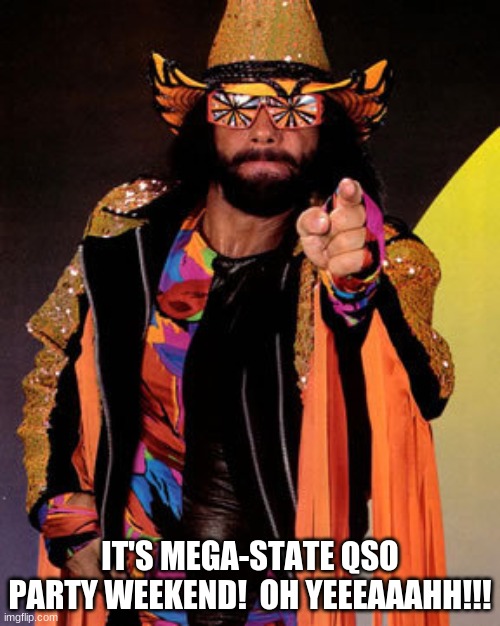
If you enjoy working state QSO parties, you’re a budding (or maybe you’re a hardcore) contester, you’re chasing your “Worked All States” award or maybe you just enjoy making stateside contacts, this weekend is for you. This weekend there are 16 (you read that right…16!) state QSO parties taking place. Scheduled for this weekend are state QSO parties in:
Arizona, Idaho, Montana, Nevada, Oregon, Utah, Washington, Wyoming, Indiana, Delaware, Connecticut, Maine, Massachusetts, New Hampshire, Rhode Island and Vermont
For additional details, go to https://www.contestcalendar.com/stateparties.html
(fyi I don’t know if The Macho Man Randy Savage (God rest his soul) was an amateur radio operator, but he was definitely a ham!)
The FCC has announced that rule changes detailed in a lengthy 2019 Report and Order governing RF exposure standards go into effect on May 3, 2021. The new rules do not change existing RF exposure (RFE) limits but do require that stations in all services, including amateur radio, be evaluated against existing limits, unless they are exempted. For stations already in place, that evaluation must be completed by May 3, 2023. After May 3 of this year, any new station, or any existing station modified in a way that’s likely to change its RFE profile — such as different antenna or placement or greater power — will need to conduct an evaluation by the date of activation or change.
“In the RF Report and Order, the Commission anticipated that few parties would have to conduct reevaluations under the new rules and that such evaluations will be relatively straightforward,” the FCC said in an April 2 Public Notice. “It nevertheless adopted a 2-year period for parties to verify and ensure compliance under the new rules.”
The Amateur Service is no longer categorically excluded from certain aspects of the rules, as amended, and licensees can no longer avoid performing an exposure assessment simply because they are transmitting below a given power level.
“For most amateurs, the major difference is the removal of the categorical exclusion for amateur radio, which means that ham station owners must determine if they either qualify for an exemption or must perform a routine environmental evaluation,” said Greg Lapin, N9GL, chair of the ARRL RF Safety Committee and a member of the FCC Technological Advisory Council (TAC).
“Ham stations previously excluded from performing environmental evaluations will have until May 3, 2023, to perform these. After May 3, 2021, any new stations or those modified in a way that affects RF exposure must comply before being put into service,” Lapin said.
The December 2019 RF Report and Order changes the methods that many radio services use to determine and achieve compliance with FCC limits on human exposure to RF electromagnetic fields. The FCC also modified the process for determining whether a particular device or deployment is exempt from a more thorough analysis by replacing a service-specific list of transmitters, facilities, and operations for which evaluation is required with new streamlined formula-based criteria. The R&O also addressed how to perform evaluations where the exemption does not apply, and how to mitigate exposure.
Amateur radio licensees will have to determine whether any existing facilities previously excluded under the old rules now qualify for an exemption under the new rules. Most will, but some may not.
The ARRL Laboratory staff is available to help amateurs to make these determinations and, if needed, perform the necessary calculations to ensure their stations comply. ARRL Laboratory Manager Ed Hare, W1RFI, who helped prepare ARRL’s RF Exposure and You book, explained it this way. “The FCC did not change any of the underlying rules applicable to amateur station evaluations,” he said. “The sections of the book on how to perform routine station evaluations are still valid and usable, especially the many charts of common antennas at different heights.” Hare said ARRL Lab staff also would be available to help amateurs understand the rules and evaluate their stations.”
RF Exposure and You is available for free download from ARRL. ARRL also has an RF Safety page on its website.
(courtesy ARRL)

In honor of the birthday of Samuel F. B. Morse, inventor of the Morse Code, April 27 is Morse Code Day! While knowledge of Morse Code is no longer a requirement to have an Amateur Radio license (it ended effective February 23, 2007), many licensees still enjoy CW and use it on the air. The ARRL broadcasts code practice daily at different times and several times a month sends a “Qualifying Run”, copying of which entitles one to a “Certificate of Code Proficiency”.
If you know CW, get on the air today and make a QSO in honor of ol’ Sam Morse, and if you don’t know it, it’s never too late to learn it!
The Lakeland Amateur Radio Club operated Special Event Station W4S at Sun ‘n Fun 2021. These are just a few of the highlights. Thanks to all who operated the station, including Mike Shreve, N6MRS; George Mann, KJ4UW; Dan Gagnon, NZ1P (and everyone else who operated but whose names were not provided)…and a couple of big shout-outs for Geoff Schuck, WA4MMO and Todd Rush, W7STR for spearheading the event. Many thanks to all for a great event!


